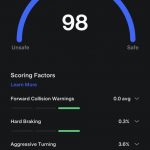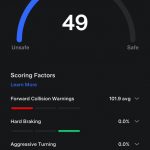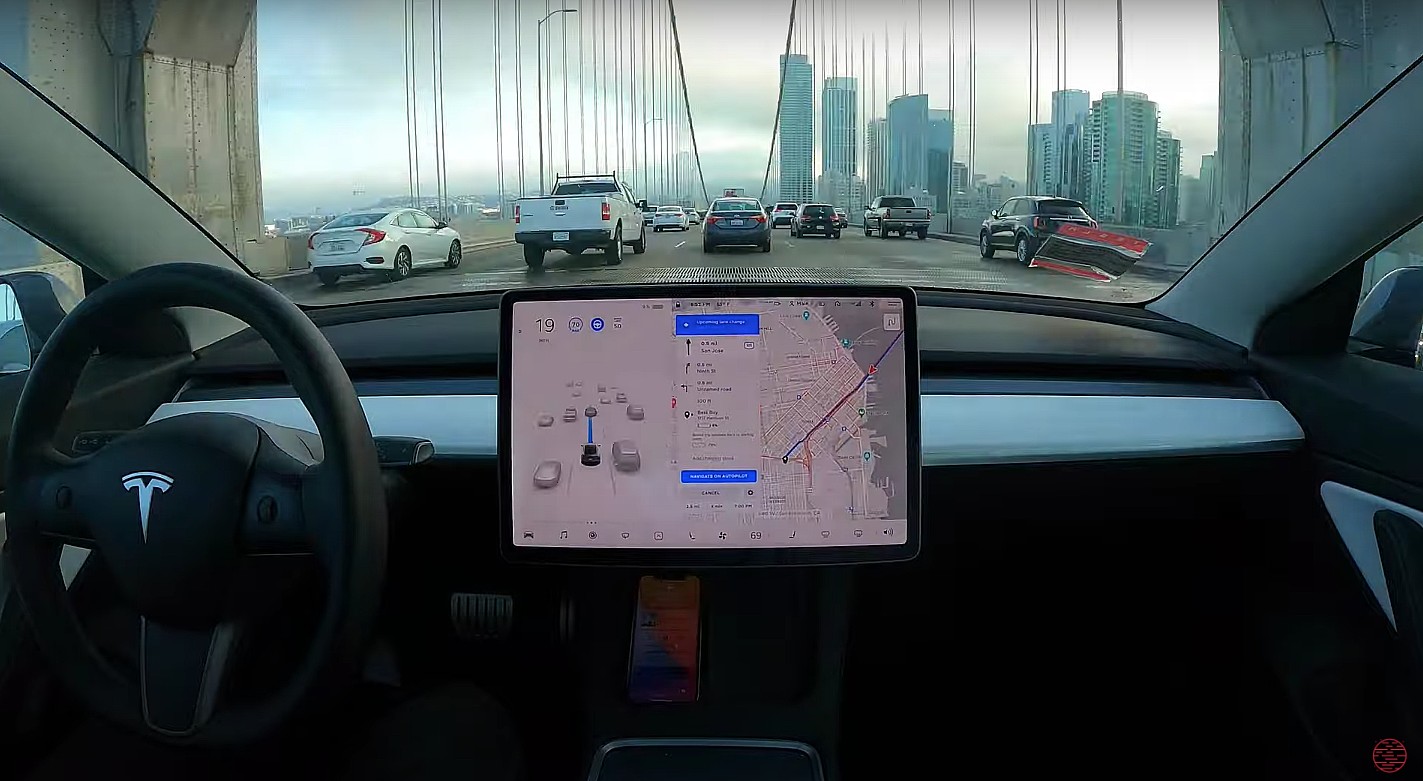
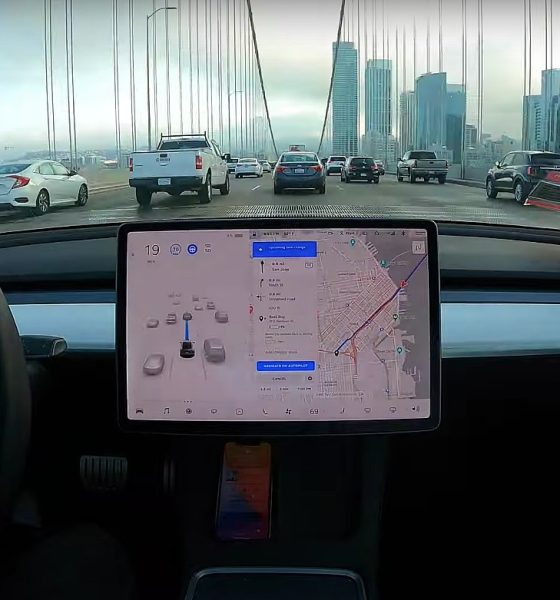
News
Tesla introduces Safety Score (Beta) system that incentivizes safe driving
As Tesla starts the rollout of its “Request Full Self Driving” button to more members of its fleet, the company has also introduced its Safety Score (Beta) system to evaluate driving behaviors. With this new system on hand, Tesla has effectively incentivized and gamified safe driving, which would likely make the rollout of programs such as FSD Beta a lot smoother and less likely to result in accidents.
Safety Scores are an assessment of driving behavior based on five metrics that the company calls “Safety Factors.” These factors are Forward Collision Warnings (FCW) per 1,000 Miles, Hard Braking, Aggressive Turning, Unsafe Following, and Forced Autopilot Disengagement. Tesla utilizes a Predicted Collision Frequency (PCF) formula based on statistical modeling using 6 billion miles of fleet data to predict how many collisions may occur per 1 million miles driven. The PCF is converted into a Safety Score between 0 and 100, which are then viewed through the Tesla App.
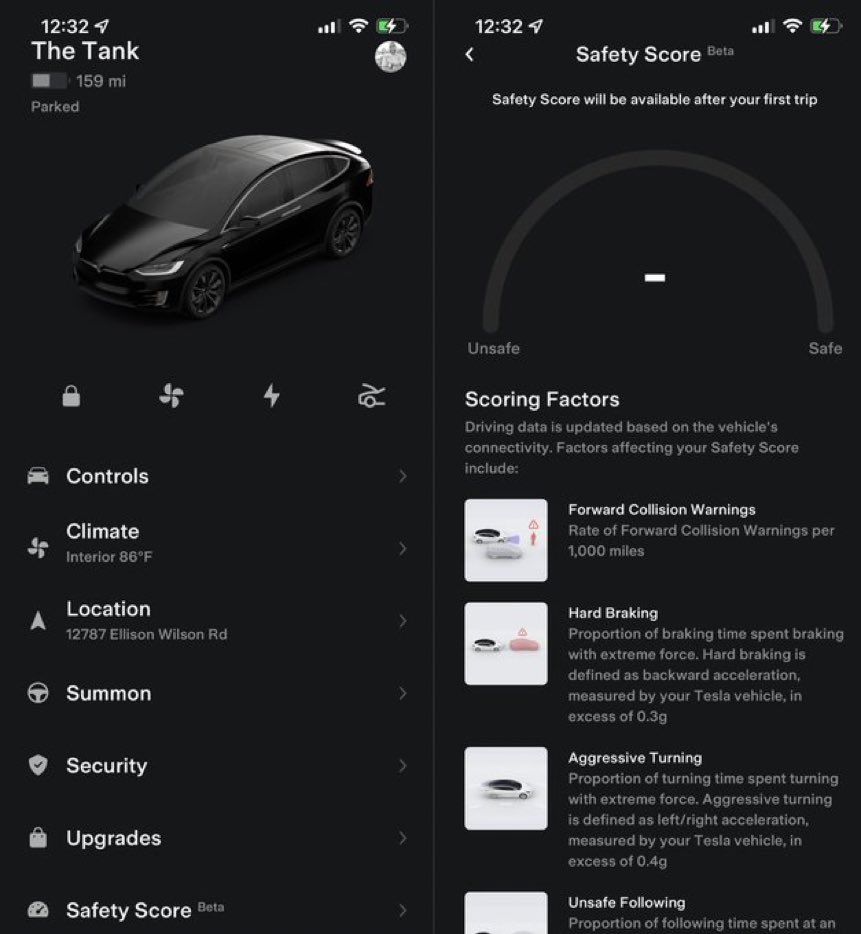
Tesla released some tips on how drivers could improve their Safety Score. To improve ratings on Forward Collision Warnings per 1,000 Miles, drivers are advised to maintain a following distance that gives enough time to react to slower or stationary vehicles ahead. Hard Braking scores, on the other hand, could be improved by engaging the brake pedal early when slowing down and using regen braking whenever possible and safe to do so. Hard Braking scores should also improve when drivers maintain a safe distance from the vehicle in front of them.
Aggressive Turning is defined as left/right acceleration in excess of 0.4g. Thus, drivers could improve their numbers in this metric by taking turns gradually, reducing their speed heading into a turn, and gradually accelerating afterward. Unsafe Following scores would likely be easy to improve, as drivers simply need to maintain a following distance worth several car lengths to the vehicle in front. This way, drivers could have enough time to react just in case something untoward happens.
Forced Autopilot Disengagement highlights the need to use the company’s advanced driver-assist features in a responsible manner. Proper Autopilot use is outlined in vehicles’ Owner’s Manual, and it requires drivers to have their hands on the wheel and pay close attention to the road. Tesla notes that the Forced Autopilot Disengagement metric is a 1 or 0 indicator, with the value being 1 if Autopilot forcibly disengages during a drive and 0 if the system is operated nominally.
- An example of a high Safety Score, reflecting generally good driving behaviors. (Credit: Jason DeBolt/Twitter)
- An example of a low Safety Score, reflecting some unsafe driving behaviors. (Credit: Tesla Raj/Twitter)
Safety Scores are updated every time a trip is taken on a Tesla vehicle. Provided that a Tesla is connected to the internet, Safety Scores should provide immediate feedback on a driving session. Vehicles that are not connected to the internet would update their Safety Scores as soon as cellular connectivity is secured. It should also be noted that all trips over 0.1 miles are considered as a valid driving session that could affect a driver’s rating.
Safety Scores are vehicle-specific as well, so drivers with multiple Teslas could have varying ratings for each of their cars. Lastly, Safety Scores should reset when a vehicle is sold, which means that a Tesla’s new owner should not be affected by the ratings of the previous driver. Drivers could also not carry over their Safety Scores from one vehicle if they purchase a new Tesla.
A full and extensive discussion of how Tesla’s Safety Scores work could be found here.
Don’t hesitate to contact us with account tips. Just send a message to tips@teslarati.com to give us a heads up.

Elon Musk
Tesla’s Elon Musk: 10 billion miles needed for safe Unsupervised FSD
As per the CEO, roughly 10 billion miles of training data are required due to reality’s “super long tail of complexity.”

Tesla CEO Elon Musk has provided an updated estimate for the training data needed to achieve truly safe unsupervised Full Self-Driving (FSD).
As per the CEO, roughly 10 billion miles of training data are required due to reality’s “super long tail of complexity.”
10 billion miles of training data
Musk comment came as a reply to Apple and Rivian alum Paul Beisel, who posted an analysis on X about the gap between tech demonstrations and real-world products. In his post, Beisel highlighted Tesla’s data-driven lead in autonomy, and he also argued that it would not be easy for rivals to become a legitimate competitor to FSD quickly.
“The notion that someone can ‘catch up’ to this problem primarily through simulation and limited on-road exposure strikes me as deeply naive. This is not a demo problem. It is a scale, data, and iteration problem— and Tesla is already far, far down that road while others are just getting started,” Beisel wrote.
Musk responded to Beisel’s post, stating that “Roughly 10 billion miles of training data is needed to achieve safe unsupervised self-driving. Reality has a super long tail of complexity.” This is quite interesting considering that in his Master Plan Part Deux, Elon Musk estimated that worldwide regulatory approval for autonomous driving would require around 6 billion miles.
FSD’s total training miles
As 2025 came to a close, Tesla community members observed that FSD was already nearing 7 billion miles driven, with over 2.5 billion miles being from inner city roads. The 7-billion-mile mark was passed just a few days later. This suggests that Tesla is likely the company today with the most training data for its autonomous driving program.
The difficulties of achieving autonomy were referenced by Elon Musk recently, when he commented on Nvidia’s Alpamayo program. As per Musk, “they will find that it’s easy to get to 99% and then super hard to solve the long tail of the distribution.” These sentiments were echoed by Tesla VP for AI software Ashok Elluswamy, who also noted on X that “the long tail is sooo long, that most people can’t grasp it.”
News
Tesla earns top honors at MotorTrend’s SDV Innovator Awards
MotorTrend’s SDV Awards were presented during CES 2026 in Las Vegas.

Tesla emerged as one of the most recognized automakers at MotorTrend’s 2026 Software-Defined Vehicle (SDV) Innovator Awards.
As could be seen in a press release from the publication, two key Tesla employees were honored for their work on AI, autonomy, and vehicle software. MotorTrend’s SDV Awards were presented during CES 2026 in Las Vegas.
Tesla leaders and engineers recognized
The fourth annual SDV Innovator Awards celebrate pioneers and experts who are pushing the automotive industry deeper into software-driven development. Among the most notable honorees for this year was Ashok Elluswamy, Tesla’s Vice President of AI Software, who received a Pioneer Award for his role in advancing artificial intelligence and autonomy across the company’s vehicle lineup.
Tesla also secured recognition in the Expert category, with Lawson Fulton, a staff Autopilot machine learning engineer, honored for his contributions to Tesla’s driver-assistance and autonomous systems.
Tesla’s software-first strategy
While automakers like General Motors, Ford, and Rivian also received recognition, Tesla’s multiple awards stood out given the company’s outsized role in popularizing software-defined vehicles over the past decade. From frequent OTA updates to its data-driven approach to autonomy, Tesla has consistently treated vehicles as evolving software platforms rather than static products.
This has made Tesla’s vehicles very unique in their respective sectors, as they are arguably the only cars that objectively get better over time. This is especially true for vehicles that are loaded with the company’s Full Self-Driving system, which are getting progressively more intelligent and autonomous over time. The majority of Tesla’s updates to its vehicles are free as well, which is very much appreciated by customers worldwide.
Elon Musk
Judge clears path for Elon Musk’s OpenAI lawsuit to go before a jury
The decision maintains Musk’s claims that OpenAI’s shift toward a for-profit structure violated early assurances made to him as a co-founder.

A U.S. judge has ruled that Elon Musk’s lawsuit accusing OpenAI of abandoning its founding nonprofit mission can proceed to a jury trial.
The decision maintains Musk’s claims that OpenAI’s shift toward a for-profit structure violated early assurances made to him as a co-founder. These claims are directly opposed by OpenAI.
Judge says disputed facts warrant a trial
At a hearing in Oakland, U.S. District Judge Yvonne Gonzalez Rogers stated that there was “plenty of evidence” suggesting that OpenAI leaders had promised that the organization’s original nonprofit structure would be maintained. She ruled that those disputed facts should be evaluated by a jury at a trial in March rather than decided by the court at this stage, as noted in a Reuters report.
Musk helped co-found OpenAI in 2015 but left the organization in 2018. In his lawsuit, he argued that he contributed roughly $38 million, or about 60% of OpenAI’s early funding, based on assurances that the company would remain a nonprofit dedicated to the public benefit. He is seeking unspecified monetary damages tied to what he describes as “ill-gotten gains.”
OpenAI, however, has repeatedly rejected Musk’s allegations. The company has stated that Musk’s claims were baseless and part of a pattern of harassment.
Rivalries and Microsoft ties
The case unfolds against the backdrop of intensifying competition in generative artificial intelligence. Musk now runs xAI, whose Grok chatbot competes directly with OpenAI’s flagship ChatGPT. OpenAI has argued that Musk is a frustrated commercial rival who is simply attempting to slow down a market leader.
The lawsuit also names Microsoft as a defendant, citing its multibillion-dollar partnerships with OpenAI. Microsoft has urged the court to dismiss the claims against it, arguing there is no evidence it aided or abetted any alleged misconduct. Lawyers for OpenAI have also pushed for the case to be thrown out, claiming that Musk failed to show sufficient factual basis for claims such as fraud and breach of contract.
Judge Gonzalez Rogers, however, declined to end the case at this stage, noting that a jury would also need to consider whether Musk filed the lawsuit within the applicable statute of limitations. Still, the dispute between Elon Musk and OpenAI is now headed for a high-profile jury trial in the coming months.
